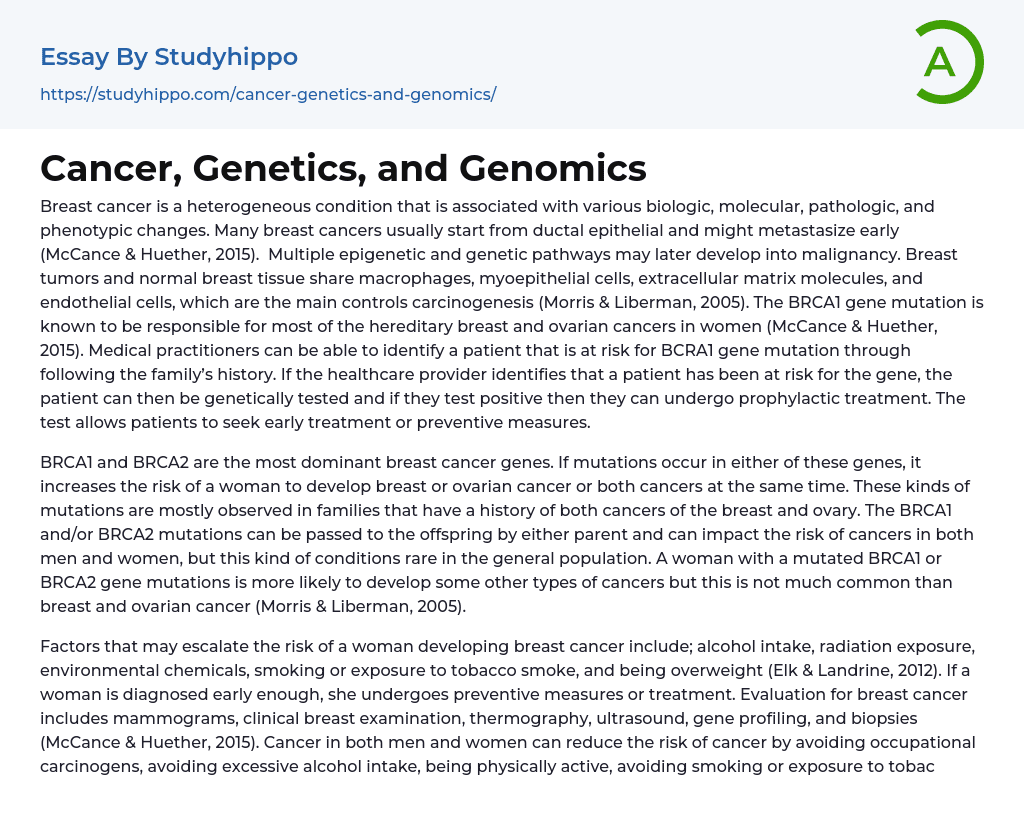Breast cancer is a heterogeneous condition that is associated with various biologic, molecular, pathologic, and phenotypic changes. Many breast cancers usually start from ductal epithelial and might metastasize early (McCance & Huether, 2015). Multiple epigenetic and genetic pathways may later develop into malignancy. Breast tumors and normal breast tissue share macrophages, myoepithelial cells, extracellular matrix molecules, and endothelial cells, which are the main controls carcinogenesis (Morris & Liberman, 2005). The BRCA1 gene mutation is known to be responsible for most of the hereditary breast and ovarian cancers in women (McCance & Huether, 2015). Medical practitioners can be able to identify a patient that is at risk for BCRA1 gene mutation through following the family’s history. If the healthcare provider identifies that a pat
...ient has been at risk for the gene, the patient can then be genetically tested and if they test positive then they can undergo prophylactic treatment. The test allows patients to seek early treatment or preventive measures.
BRCA1 and BRCA2 are the most dominant breast cancer genes. If mutations occur in either of these genes, it increases the risk of a woman to develop breast or ovarian cancer or both cancers at the same time. These kinds of mutations are mostly observed in families that have a history of both cancers of the breast and ovary. The BRCA1 and/or BRCA2 mutations can be passed to the offspring by either parent and can impact the risk of cancers in both men and women, but this kind of conditions rare in the general population. A woman with a mutated BRCA1 or BRCA2 gene mutations is more likely to develop some other types of cancers but thi
is not much common than breast and ovarian cancer (Morris & Liberman, 2005).
Factors that may escalate the risk of a woman developing breast cancer include; alcohol intake, radiation exposure, environmental chemicals, smoking or exposure to tobacco smoke, and being overweight (Elk & Landrine, 2012). If a woman is diagnosed early enough, she undergoes preventive measures or treatment. Evaluation for breast cancer includes mammograms, clinical breast examination, thermography, ultrasound, gene profiling, and biopsies (McCance & Huether, 2015). Cancer in both men and women can reduce the risk of cancer by avoiding occupational carcinogens, avoiding excessive alcohol intake, being physically active, avoiding smoking or exposure to tobacco smoke, and checking weight. By choosing healthy lifestyles options that are possible can drastically reduce the risk of an individual to develop cancer.
References
- Elk, R., & Landrine, H. (2012). Cancer disparities: Causes and evidence-based solutions. New York: Springer Pub. Co.
- McCance, K. L., & Huether, S. E. (2015). Pathophysiology: The biologic basis for disease in adults and children. Elsevier Health Sciences.
- Morris, E., & Liberman, L. (2005). Breast MRI: Diagnosis and intervention. New York: Springer.
- Apoptosis essays
- Asthma essays
- Black Death essays
- Breast Cancer essays
- Cholesterol essays
- Chronic essays
- Chronic Pain essays
- Death essays
- Diabetes essays
- Down Syndrome essays
- Epidemic essays
- Hypertension essays
- Infection essays
- Infertility essays
- Myocardial Infarction essays
- Pain essays
- Pathogen essays
- Pregnancy essays
- Sexually Transmitted Disease essays
- Symptom essays
- Tuskegee Syphilis Experiment essays
- Water supply essays
- Addiction essays
- Anatomy and Physiology essays
- Biodegradation essays
- Cancer essays
- Dental Care essays
- Disability essays
- Disease essays
- Disorders essays
- Health Care essays
- Infectious Disease essays
- Inquiry essays
- Intelligence Quotient essays
- Lung Cancer essays
- Medicine essays
- Neurology essays
- Nutrition essays
- Olfaction essays
- Physical Exercise essays
- Public Health essays
- Sex essays
- Women's Health essays
- World health organization essays




